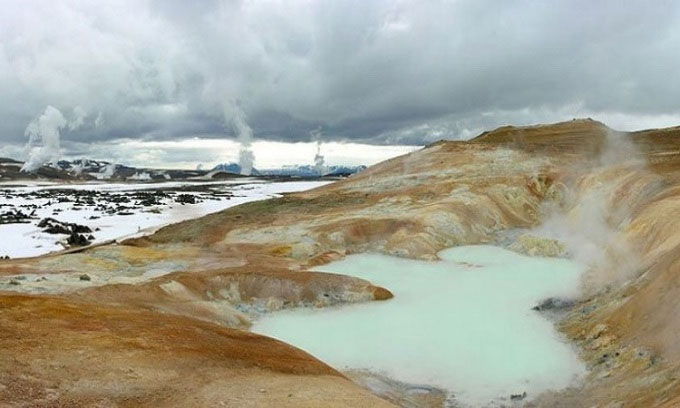Researchers Plan to Drill Deep into Krafla Volcano to Study the 500 Million m3 Magma Chamber Below.
With its large turquoise lake, billowing smoke columns, and bubbling sulfur, Krafla Volcano is among the most impressive natural wonders of Iceland. In the northeastern region of the country, an international team of researchers is preparing to drill 2 kilometers deep into the volcano as part of a project aimed at creating the world’s first underground magma observatory.

Krafla Volcano in Iceland. (Photo: Wikipedia).
Launched in 2014, with the first drilling scheduled to begin in 2024, the $100 million project brings together scientists and engineers from 38 institutions and companies across 11 countries, including the United States, the United Kingdom, and France. The research team, known as the “Krafla Magma Testbed” (KMT), hopes to reach the magma chamber of the volcano.
Unlike lava that erupts on the surface, the molten rock beneath the volcano remains a mystery to researchers. KMT is the first magma observatory in the world, according to Paolo Papale, a volcanologist at the National Institute of Geophysics and Volcanology in Italy (INGV). Papale and his colleagues have never observed magma underground, except for accidental encounters while drilling in Hawaii, Kenya, and at Krafla in 2009. Scientists hope this new project could lead to significant advancements in geothermal energy exploration and expand understanding of volcanic risks and eruption predictions. Papale emphasizes that knowing the precise location of the magma chamber is crucial for pre-eruption preparations.
Like many scientific breakthroughs, the magma observatory is the result of an unexpected discovery. In 2009, when engineers were expanding the Krafla geothermal power plant, a drilling rig accidentally struck a magma pocket heated to 900 degrees Celsius at a depth of 2.1 kilometers. Smoke erupted from the borehole, and lava spewed up to 9 meters high, damaging drilling equipment, but no eruption occurred, and no one was injured.
Volcanic experts realized they might be close to a magma chamber estimated to contain around 500 million m3 of magma. They were surprised to find magma at such a shallow depth. Previously, the research team had planned to drill as deep as 4.5 kilometers. Subsequent studies indicated that the magma shared many characteristics with the eruption of 1724, suggesting it is at least 300 years old. This discovery could potentially become a breakthrough in understanding everything from continental origins to volcanic activity and geothermal systems.
The accidental discovery also piqued the interest of Landsvirkjun, Iceland’s national power company. The magma in the nearby area is in a liquid state, meaning it is rock heated to a temperature so high that it reaches a “supercritical” state, a condition between liquid and gas. The energy generated there is 5 to 10 times stronger than that of a conventional borehole. The steam rising to the surface reaches 450 degrees Celsius, the highest temperature of volcanic steam ever recorded.
Landsvirkjun hopes that the KMT project will help develop new technology capable of drilling deeper and harnessing previously untapped energy sources, according to Vordis Eiriksdottir, the geothermal operations and resource management director. However, drilling in such extreme environments poses significant technical challenges. The materials used must withstand erosion caused by superheated steam. John Eichelberger, a geophysicist at the University of Alaska Fairbanks and one of the KMT project founders, does not rule out the possibility that drilling activities could trigger a concerning volcanic eruption.


















































